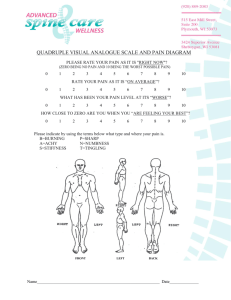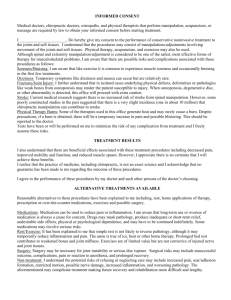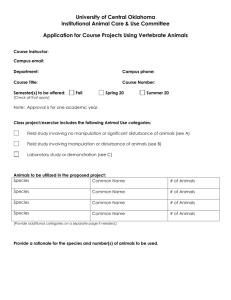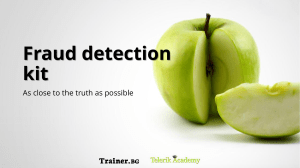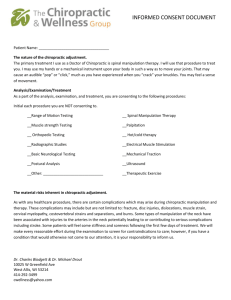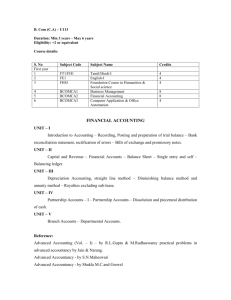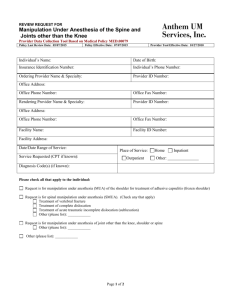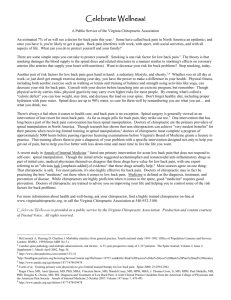History of Manipulation - American Physical Therapy Association
advertisement
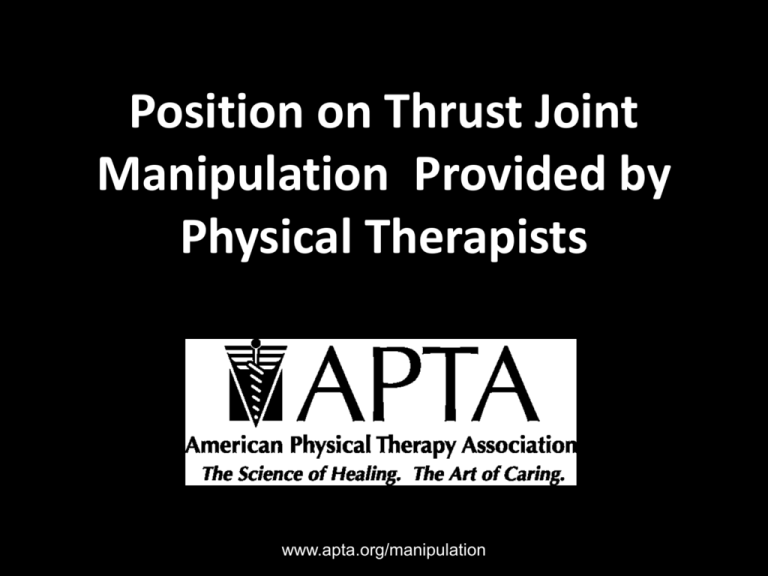
Position on Thrust Joint Manipulation Provided by Physical Therapists www.apta.org/manipulation thrust & non-thrust technique Manipulation Guide to PT PracticeMobilization/Manipulation = “A manual therapy technique comprised of a continuum of skilled passive movements to joints and/or related soft tissues that are applied at varying speeds and amplitudes, including a small amplitude/high velocity therapeutic movement” Manipulation Education Committee, June 2003- Thrust Joint Manipulation (TJM)- high velocity, low amplitude therapeutic movements within or at end range of motion. Legislative Challenges • Opposition to PTs performing TJM started in 1960s • Opposition intensified in the 1990s in response to PT professions movement toward direct access and Doctoral education – 23 states had legislative challenges in 1998 • Number of legislative challenges is less per year (typically 4-8 states), but the intensity of the legislative and regulatory challenges continues PT profession response • Orthopaedic Section of APTA was founded in part in 1974 to mobilize an organized response to chiropractic challenges • AAOMPT founded 1992 partially for the same purpose and to meet international standards of residency/fellowship training in OMPT • APTA Manipulation Task Force formed in 1999 to further coordinate APTA/AAOMPT response to chiropractic legislative challenges APTA Manipulation Task Force • AAOMPT, Orthopaedic Section, Education Section, APTA State Governmental Affairs, & APTA Education department • 1999 strategic planning meeting goals – Support state chapters and APTA in dealing with threats from chiropractors in scope of OMPT practice – Develop consistency in AAOMPT & APTA documents – Enhance level of instruction in OMPT in professional education National Chiropractic Agenda to Own Manipulation And eliminate the competition… Evidence of a Coordinated National Chiropractic Agenda • Multiple states encounter the same chiropractic challenges in the same year • Shift in strategy the following year • 2003 and 2004 prime examples 2003 Chiropractic legislation in the states • Used strategy of education-based prohibition on manipulation. • 2003 states: Hawaii, Iowa, Louisiana, New Mexico, North Dakota, Texas, and Tennessee Example of ’03 Chiropractic Legislation in the states • A person may not perform a spinal manipulation or spinal adjustment without first having the legal authority to differentially diagnose and have received a minimum of four hundred hours of classroom instruction in spinal manipulation or spinal adjustment and a minimum of eight hundred hours of supervised clinical training at a facility where spinal manipulation or spinal adjustment is a primary method of treatment. 2004 Chiropractic/Manipulation In 2004, legislation moved back toward flat out prohibition – Iowa, New York, New Jersey, Oklahoma, South Carolina South Carolina HB 4676/SB 1035 • Only a licensed chiropractor may perform a specific spinal adjustment/manipulation on a patient. • 'Adjustment or manipulation' means the forceful movement of joints or tissue to restore joint function, in whole or part, to increase circulation, to increase motion, or to reduce\ interosseous disrelation. Chiropractic motivation • Economics seems to be the primary reason for the legislative challenges • “The biggest competitive threat will come from physical therapists” – The Future of Chiropractic Revisited: 2005-2015 Chiropractic Arguments • TJM is outside of PT scope of practice • PTs lack training in TJM • Patient safety is compromised when TJM is performed by physical therapists History of Manipulation The History is on our side History of Manipulation • Hippocrates, Father of Medicine – 460-355 B.C. – Wrote “On Setting Joints by Leverage” – Spinal Traction – Reduction of dislocated shoulders Bone Setters • Friar Moulton – published, “The Complete Bone-Setter”, 1656 • Bone setting flourished in Europe during the period of 1600-early 1900’s – No formal training – Techniques passed down within families – Clicking sounds thought to be due to moving bones back into place History of Manipulation • Wharton Hood – 1871, “On Bone-setting” • first such book by an orthodox medical practitioner • Hood thought snapping sound was due to breaking adhesions • PT evolved from Medicine • Precedes Osteopathy and Chiropractic – In 1887, PTs were given official registration by Sweden’s National Board of Health and Welfare – 1899 Chartered Society of Physiotherapy founded in England Osteopathy Andrew Still founded Osteopathy in 1874 – 1896 founded the first school of Osteopathy in Kirksville, Missouri – “Rule of the Artery”Manipulate the spine to restore blood flow and restore body’s innate healing ability – Osteopaths currently licensed to practice medicine in all states Chiropractic Founded 1895 • “Chiropractors do not manipulate; they do not use the process of manipulating; they adjust.” D. D. Palmer (1845 - 1913), founder of Chiropractic. "The Chiropractor's Adjuster," 1910. History of Chiropractic • DD Palmer, a magnetic healer and green grocer applied an “adjustment” to Harvey Lillard in September 1895 to the T4 vertebra that resulted in restoration of lost hearing • Concept of “subluxation” as a causal factor in disease and the revelation that adjustments can restore the body’s innate healing abilities • Palmer School of Chiropractic founded in 1897 in Davenport, Iowa Chiropractic Philosophy • Belief in body’s innate ability to heal itself • Presence of a “subtle” energy within the organism • “The Law of the Nerve” – Adjust spinal “subluxations” to restore nerve flow and facilitate the body’s innate healing ability Chiropractic History • 1904, BJ Palmer (18811961) gained operational control of the School and continued until 1961 • BJ is considered the “Developer” of chiropractic and defender of “straight” chiropractic • “Staights” adhere to original philosophy • “Mixers” incorporate other modalities Chiropractic Heritage Belief • Chiropractors claim to be the first professionals to develop manipulation • Chiropractors have a 110+ year history of practicing and protecting their right to manipulate • All other professions are infringing on the chiropractic scope of practice who wish to use manipulation Physical Therapy in Sweden (1813) Per Henrik Ling “Father of Swedish Gymnastics” founded Royal Central Institute of Gymnastics (RCIG) in 1813 Medical gymnastics Educational gymnastics Military gymnastics Swedish word for physical therapist is “sjukgymnast” = “gymnast of the sick” Practitioners came from throughout Europe to learn PT techniques at RCIG including Jonas H. Kellgren (1837-1916) (Grandfather to James Cyriax) Anders Ottoson www.chronomedica.se What does US Physical Therapy history say about "manipulation"? • Mary McMillan, 1st president of APTA (founded 1921) • The four branches of physiotherapy: “namelymanipulation to muscle and joint, therapeutic exercise,… electrotherapy, and hydrotherapy." – McMillan M. Change of name [editorial]. P. T. Review. 1925b;5(4):3-4. McMillan’s 1921/1925 book is based on the teachings of Ling and RCIG in Sweden “Medical gymnastics” and “therapeutic exercise” are synonymous terms Massage (manipulation) are “movements done upon the body” Exercise are “movements done with a part of the body” McMillan uses the word “manipulation” throughout her book to describe techniques such as effleurage, tapotement , friction massage, paddle technique Mary McMillan from Massage and Therapeutic Exercise, Philadelphia and London, W. B. Saunders Company, 2nd edition, 1925. Manipulation in American PT • 1925 – 1939: Yearly publications in Physical Therapy literature on Manipulation and related topics • 1940 – mid 1970’s: The word “manipulation” is not widely used in the literature – Mobilization/articulation used to separate PT from chiropractic Physical Therapists who advanced practice of manipulation • Freddy Kaltenborn – The Spine, …Mobilization 1961 – Nordic approach – First to relate manipulation to arthrokinematics • Geoffrey Maitland – “Vertebral Manipulation”, 1964 – Treats “reproducible signs” – Oscillatory techniques (Grades I-V) Physical Therapists who advanced practice of manipulation • Stanley Paris – Spinal Lesion, 1965 – Educated PT’s in U.S. in manual therapy – Founding member of AAOMPT and first president of the Orthopaedic Section – Founder of University of St. Augustine • Maitland, Kaltenborn, and Paris established long term Manual Therapy education programs for PTs in the USA and abroad Current History and the Future • Evidence Based Practice • Physical Therapists are the leaders in the diagnosis and management of “Movement” Disorders – Evidence shows that manipulation and exercise are PTs most useful tools • Professional Associations promote and protect scope of practice Historical Summary • No one profession invented or owns Manipulation • Traditional Chiropractic is based on unproven theories – “Law of the nerve” – “Subluxation theory” • Manipulation has been a vital part of the scope of PT practice since the inception of the profession TJM and PT training Professional Education & Legislation We can show; • Manipulation is within the scope of physical therapy practice. • The entire continuum of manipulation procedures (thrust and non-thrust) are taught in professional physical therapist education. CAPTE • The Commission on Accreditation in Physical Therapy Education (CAPTE) is the sole accreditation agency recognized by the United States Department of Education (USDE) and the Council for Higher Education Accreditation (CHEA) to accredit entry-level physical therapist and physical therapist assistant education programs. Physical Therapist Curriculum • CAPTE Evaluative Criteria requires physical therapist education programs to teach thrust and non-thrust manipulation of the spine and extremities • Manipulation Education Manual (APTA/AAOMPT) developed in 2004 to further enhance level of instruction in manipulation • Textbooks such as “Manual Physical Therapy of the Spine” (Saunders, Elsevier 2009) written by Physical Therapists – http://www.us.elsevierhealth.com – CDMNP.mp4 PT education • Emphasis on problem solving and an Evidence-based approach • PT education focuses on clinical decision making and meeting educational objectives • TJM is integrated into clinical science courses rather than stand alone courses • Advanced specialty PT training is obtained through long term fellowship programs Spinal Manipulation in Physical Therapist Professional Degree Education: A Model for Teaching and Integration into Clinical Practice Timothy W. Flynn, PT, PhD, OCS, FAAOMPT Robert Wainner, PT, PhD, ECS, OCS, FAAOMPT Julie Fritz, PT, PhD, ATC Flynn, JOSPT 2006 PT students employed mobilization and manipulation in episodes of care for lumbar impairments and achieved excellent outcomes 70 Frequency % 60 50 Eval WK1 DC 40 30 20 10 0 Manipulation Mobilization Flynn, JOSPT 2006 Student Outcomes Eight first year PT students treated patients with LBP: • N = 61 patients with LBP • Age = 34 • Duration Symptoms = 112 days • Prior Episode = 65% • 50% with butt/thigh or leg symptoms • Total Visits = 6.2 (+/- 4 visits) Results: • Pain rating initial: 6.0 +/- 1.7 and at d/c: 1.8 +/- 1.2 • ODI initial: 33.8 and at d/c: 13.4 Flynn, JOSPT 2006 PTs receive training in TJM • PT education emphasizes movement sciences and analysis – Expertise is grounded in anatomy, physiology, biomechanics, and pathology – Provides foundation for determining clinical decision making needed for TJM • Students receive psychomotor training and testing required for safe TJM Physical Therapists Clinical Decision Making • PTs are trained to recognize indications, contraindications, and red flags to performance of manipulation • PTs function as part of a health care team and are trained to refer to the appropriate medical professional if further diagnostic testing is indicated TJM and Patient Safety Credentialing/Licensure • State licensure and state licensing boards are in place to assure physical therapists practice within their scope of practice and to protect the public – Thrust and non-thrust manipulation are included in the PT licensure exam Malpractice • Maginnis and Associates liability Insurance carrier has provided a letter to APTA stating that there is no evidence of higher claims losses due to PTs utilizing manipulative procedures – (APTA Manipulation Action Packet) Radiology Training • “It is critical to be able to read and interpret xrays, MRI’s, and CT scans in order to make a proper diagnosis for indication for manipulation, as well as contraindication for manipulation” • “Physical Therapists have no training in radiology interpretation” Daniel M. Wik MD, DC Nebraska mediation hearing on manipulation, July 2008 Imaging • Excessive use of imaging has been cited as a cause of escalating health care costs • Clinical practice Guidelines have recommended to refrain from ordering radiographs in the absence of red flags – Van Tulder M, Tuut M, Pennick V, Bombardier C, Assendelft W. Quality of Primary Care Guidelines for Acute Low Back Pain. Spine. 2004;29(17):357-362. PTs screen for Red Flags and refer for further diagnostic testing indicated prior to treatment Significant trauma Weight loss History of cancer Fever Intravenous drug use Steroid use Patient over 50 years Severe, unremitting night-time pain Pain that gets worse when lying down New Zealand Acute Low Back Pain Guide 2003/ www.nzgg.org.nz What Are the Risks of serious complications from lumbar TJM? Haldeman and Rubenstein (Spine, 1992) – Reviewed the literature over 77 year period – Ten episodes of cauda equina syndrome following lumbar manipulation reported (none from PTs) – Estimated risk: < 1 per 10 million manipulations Potential Complication Procedure Reported Risk Est # / 10,000 Lumbo-Sacral Manipulation 1 / 10,000,000 0.001 Exercise 1 / 1,500,000 0.007 Sudden Death NSAIDS 1- 3 / 100 100 – 300 GI bleed ESI (w/ fluoroscopy) 8 – 11 / 100 800 - 1100 Intravascular Injection Disc Surgery 1.6 – 17 / 10,000 1.6 – 17 Vascular perforations Disc Surgery 3.8 / 10,000 3.8 Visceral injuries 17 / 100 1700 Varied 0.2-0.3 / 100 20 – 30 Death Fusion Discectomy, laminectomy, +/fusion Cauda Equina Neurovascular Injury from Cervical Spine TJM • What are the risks? What are the Risks? (Di Fabio, Phys Ther, 1999) • 177 patients (1925-1997) who experienced adverse events with manipulation • 39.6 years (4 months - 87 years), even distribution between males and females (80 males, 90 females) • Primary diagnoses included arterial dissection/spasm and brain stem lesions • 32 cases (18%) resulted in death • <2% adverse events caused by PTs (no deaths caused by PTs) Mechanism of VBI (Haldeman, Spine, 1999) • • • • 367 cases between 19661993 involving vertebral artery dissection and/or occlusion, regardless of the mechanism of injury Major trauma – MVA, fall, direct impact, contact sport injuries, etc. Trivial trauma – sudden head movements, sporting activities, sustained rotation and/or extension, backing out of driveway Spontaneous – non-recent trauma, past VBI, driving in car, pregnancy, standing up briskly after a nap Mechanism Spontaneous No. (%) of cases 160 (43) Cervical manip 115 (31) Trivial trauma 58 (16) Major trauma 37 (10) Total 367 Quantifying the Risk? • Impossible to determine the precise risk – Not all events published in peer-reviewed literature – No accepted standard for reporting these injuries • Risk of serious complications approximately 6 per 10 million* (Hurwitz, Spine, 1996) • Risk of death estimated at 3 in 10 million* manipulations (Hurwitz, Spine, 1996) *Adjusted risk based on assumption that only 1 in 10 reported in literature Summary - safety • Benefits outweigh the risks as long as clinical decision making is based on thorough examination and Evidence-based impairmentbased approach – Screen for red flags – Consider contraindications – Modify techniques when appropriate • More risk with other common medical and surgical interventions than manipulation • Physical Therapists clinical decision-making philosophy facilitates safe practice Research Supporting Use of TJM Hierarchy of Evidence for Treatment Higher levels of study design allow you to have increased confidence in the conclusions drawn from the study. Systematic Reviews & Metaanalyses of RCTs Multiple RCTs Randomized Controlled Trial (RCT) Systematic Review of the studies below Observational Cohort or Case Control Studies, Large Case Series Case Reports, Small Case Series Unsystematic Clinical Observations LBP Clinical Practice Guidelines • AHCPR (‘94) - Manipulation can be helpful for patients with acute low back problems without radiculopathy when used within the first month of symptoms. (Strength of Evidence = B) –First major clinical guideline to recommend TJM for LBP What profession provided the Manipulation in the referenced Randomized Controlled Trials? Physical Therapy. 2000; 80 (8):820-823 Totals for all reports cited by either AHCPR or RAND treatment guidelines that support manipulation •Chiropractors: 5 (18%) •MD: 10 •Osteopath: 3 •PT: 12 (40%) LBP Clinical Practice Guidelines • NZGG (‘98)- Manual loading of the spine using short or long leverage methods is safe and effective in the first 4-6 weeks of acute low back symptoms. (Strength of Evidence = Moderate) • RCGP (’96 & ‘01)- Within the first six weeks of onset of acute or recurrent low back pain, manipulation provides better short-term improvement in pain and activity levels and higher patient satisfaction than the treatments to which it has been compared. (Strength of Evidence = ) Manipulation/Mobilization Systematic Review (Gross, Cochrane Collaboration, 2004) • Strong evidence supporting thrust and/or nonthrust manipulation plus exercise to improve short- and long-term outcomes of care for patients with neck pain disorders The Bone and Joint Decade 2000–2010 Task Force on Neck Pain and Its Associated Disorders Executive Summary Scott Haldeman, DC, MD, PhD,* Linda Carroll, PhD,† J. David Cassidy, DC, PhD, DrMedSc,‡ Jon Schubert, CMA,§ and Åke Nygren, DDS, MD, DrMedSc¶ SPINE Volume 33, Number 4S, pp S5–S7 ©2008, Lippincott Williams & Wilkins The Bone and Joint Decade 2000–2010 Task Force on Neck Pain and Its Associated Disorders • Educational videos, mobilization, manual therapy, exercises, low-level laser therapy, and perhaps acupuncture appeared to have benefit. • WAD and other neck pain without radicular symptoms, interventions that focused on regaining function and returning to work as soon as possible were relatively more effective than interventions that did not have such a focus. Summary-Evidence • Greater evidence for spinal manipulation than most other PT interventions – Strong evidence for Thrust manipulation for subgroup of patients with Acute LBP – Strong evidence for mobilization /manipulation combined with exercise for subgroup of patients with neck pain • Clinical predictions rules (CPR) have been developed by physical therapists to help guide clinical decisionmaking in use of TJM • CPRs should be integrated with an impairment-based approach Summary--Value • Billions of $ spent to treat musculoskeletal conditions each year. • Exercise combined with Manipulation provided by physical therapists may be part of the solution • Chiropractors feel threatened and are fighting back with regulatory and legislative strategies PT are educated, effective, and Safe at TJM • Non-PT agencies have investigated PT competence in TJM and have determined that TJM is within PT scope of practice including: – Veterans Hospital Association – US department of Health and Human Services – Virginia board of Medicine Attempts to limit PTs from using Manipulation is based on Economics---not patient safety The health and welfare of the public is best served by physical therapists providing manipulation! olsonpt@comcast.net Contributors to presentation • • • • • • • Bill Boissonnault PT, DHSc Josh Cleland PT, PhD Tim Flynn PT, PhD Stephen McDavitt PT, DPT Ken Olson PT, DHSc (chair) Stanley Paris PT, PhD Bob Rowe PT, DPT
